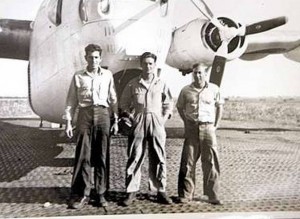Hunting Nazi Submarines Out Of Bermuda
 A former New York state legislator recalls his days duelling with Nazi U-Boats off Bermuda during the Second World War in a profile published in the “Buffalo News” today [Jan. 23].
A former New York state legislator recalls his days duelling with Nazi U-Boats off Bermuda during the Second World War in a profile published in the “Buffalo News” today [Jan. 23].
Inspired by a family tradition of military service, engineering student Walter J. Floss Jr. enlisted in the US Naval Reserve on his 17th birthday, February 13, 1940 — more than 18 months before America entered World War Two [1939-1945] following the Japanese surprise attack on Pearl Harbour in Hawaii.
His father had served in the Army’s 106th Field Artillery in France during World War I, and before that, one of Floss’ grandfathers had fought for the North in the Civil War.
He trained to be a crew member on a PBY Catalina, an American flying boat of the 1930s and 1940s produced by Consolidated Aircraft that proved to be one of the most widely used multi-role aircraft of World War II [he is pictured above with fellow fliers].
During the war, PBYs were used in anti-submarine warfare, patrol bombing, convoy escorts, search and rescue missions and cargo transport.
By May 1942, Mr. Floss had been assigned to the US Naval Operating Base [NOB] in Southampton, Bermuda [now Morgan's Point], where the PBYs patrolled the Atlantic in search of German submarines seeking to sink US troop ships headed to England.
Along with a major base the East End, the NOB was one of two American military installations established here during the Second World War
Documentary On The PBY-Catalina Flying Boat Which Flew Out Of Bermuda
“We got a few of the subs until the Germans realised our depth charges hung on racks under our wings,” Mr. Floss told the Buffalo newspaper. “Our depth charges were set to detonate at 100 feet underwater, but we couldn’t change the setting of the charge while in flight.
“The Germans then stayed on the surface, and we were horribly outgunned by the subs. Three of our planes were shot down. We switched to a Navy version of the B-24 bomber, and the ordnance men could set the depth charges to whatever was required inside the plane’s bomb bay.”
Shortly after Mr. Floss left Bermuda during an early morning gunnery exercise on January 10, 1943, a PBY Catalina belonging to his old unit attempted a pass over the target area on the Great Sound and unexpectedly dove into the water at a high rate of speed near Grace Island. The entire eight-man crew was killed in the first ever deadly air crash in Bermuda.
Mr. Floss eventually ended up flying above the Mediterranean—from Port Lyautey in Morocco to the Rock of Gibraltar—to fight off German subs trying to sink troop ships preparing for the Allied invasion of Italy.
After that invasion, he was sent to England to preparare for the invasion of northern France on D-Day.
Following the war he returned to the Buffalo area and worked as an insurance salesman and at Bell Aerospace before embarking on a career in local politics which culminated in his election to the New York State Senate.


Just a point of detail, the aircraft in the picture is not a PBY. It is not even a flying boat type of aircraft. It looks to be a B24 Liberator, a land based 4 engined bomber of WW2.
Read he screed – both are depicted!
Well spotted TD, I saw noticed that too.